-
 Bitcoin
Bitcoin $116400
-0.36% -
 Ethereum
Ethereum $4033
3.40% -
 XRP
XRP $3.302
-1.26% -
 Tether USDt
Tether USDt $1.000
-0.02% -
 BNB
BNB $796.1
1.67% -
 Solana
Solana $177.8
1.89% -
 USDC
USDC $0.9999
0.00% -
 Dogecoin
Dogecoin $0.2314
4.09% -
 TRON
TRON $0.3381
0.14% -
 Cardano
Cardano $0.7989
1.22% -
 Stellar
Stellar $0.4496
-1.84% -
 Chainlink
Chainlink $20.42
9.42% -
 Hyperliquid
Hyperliquid $41.17
0.88% -
 Sui
Sui $3.914
3.77% -
 Bitcoin Cash
Bitcoin Cash $584.7
1.52% -
 Hedera
Hedera $0.2632
-0.54% -
 Avalanche
Avalanche $24.09
3.40% -
 Ethena USDe
Ethena USDe $1.001
-0.02% -
 Litecoin
Litecoin $123.2
1.33% -
 Toncoin
Toncoin $3.318
-0.04% -
 UNUS SED LEO
UNUS SED LEO $8.984
-0.05% -
 Shiba Inu
Shiba Inu $0.00001323
2.85% -
 Uniswap
Uniswap $10.90
4.41% -
 Polkadot
Polkadot $3.999
3.34% -
 Dai
Dai $1.000
0.01% -
 Cronos
Cronos $0.1630
9.64% -
 Bitget Token
Bitget Token $4.484
0.82% -
 Monero
Monero $272.4
2.44% -
 Pepe
Pepe $0.00001173
6.03% -
 Aave
Aave $290.8
2.88%
Bitcoin ETF: How to Choose the Right One for Your Investment Strategy
A Bitcoin ETF offers regulated, stock-like exposure to Bitcoin’s price without the need for direct ownership or crypto wallets.
Aug 09, 2025 at 11:49 am

Understanding Bitcoin ETFs and Their Market Role
A Bitcoin ETF (Exchange-Traded Fund) is a financial product that tracks the price of Bitcoin without requiring investors to directly own or store the cryptocurrency. These funds trade on traditional stock exchanges, making them accessible to investors who prefer regulated, brokerage-based platforms over crypto wallets and exchanges. The introduction of Bitcoin ETFs marked a pivotal moment in the convergence of traditional finance and digital assets, offering institutional and retail investors a compliant way to gain exposure to Bitcoin’s price movements.
Unlike buying Bitcoin on a crypto exchange, investing in a Bitcoin ETF eliminates the need for private key management, cold storage, or navigating decentralized platforms. Instead, investors purchase shares through a brokerage account, similar to buying stocks. The underlying asset of a spot Bitcoin ETF is actual Bitcoin held by a custodian, while futures-based Bitcoin ETFs derive value from Bitcoin futures contracts traded on regulated derivatives markets. This distinction is critical when aligning with investment goals, risk tolerance, and tax considerations.
Spot vs. Futures-Based Bitcoin ETFs: Key Differences
When evaluating Bitcoin ETFs, one of the most important distinctions is whether the fund is spot-based or futures-based.
- A spot Bitcoin ETF holds actual Bitcoin in secure custody. The value of the ETF directly reflects the current market price of Bitcoin. These ETFs aim to mirror the spot price with minimal tracking error. Examples include the iShares Bitcoin Trust (IBIT) and ARK Invest’s ARKB.
- A futures-based Bitcoin ETF, such as the ProShares Bitcoin Strategy ETF (BITO), does not hold Bitcoin directly. Instead, it invests in CME-traded Bitcoin futures contracts. These contracts have expiration dates and must be rolled over, which can lead to contango or backwardation, potentially affecting returns over time.
Investors seeking pure price exposure with lower complexity should prioritize spot Bitcoin ETFs. Those comfortable with derivatives and short-term trading strategies might consider futures-based options, though they often carry higher fees and compounding slippage due to contract rollovers.
Evaluating Fund Structure and Custodial Security
The safety and legitimacy of a Bitcoin ETF depend heavily on its custodial arrangements and fund structure. Since spot ETFs hold real Bitcoin, the identity and reputation of the custodian are paramount. Leading ETFs use regulated, insured custodians such as Coinbase Custody, Paxos Trust, or Bank of New York Mellon.
When reviewing a Bitcoin ETF, confirm the following:
- The custodian is a licensed financial institution with a proven track record in digital asset custody.
- The fund discloses regular proof-of-reserves or undergoes third-party audits.
- Cold storage solutions are used, with multi-signature wallets and geographically distributed key management.
- Insurance coverage is in place to protect against theft or loss.
Transparency in holdings is another critical factor. Reputable Bitcoin ETFs publish daily updates of their Bitcoin holdings, allowing investors to verify alignment between shares outstanding and on-chain reserves. Lack of transparency should raise red flags.
Assessing Expense Ratios and Liquidity Metrics
Cost efficiency plays a major role in long-term returns. The expense ratio—the annual fee charged by the ETF provider—varies significantly across products. For example:
- BlackRock’s IBIT offers a 0.12% expense ratio during its promotional period.
- Grayscale Bitcoin Trust (GBTC) charges 1.5%, historically higher due to its early-mover status and conversion from a private trust to a public ETF.
Lower expense ratios benefit investors through reduced drag on performance. However, cost should not be the sole deciding factor. Liquidity is equally important. A highly liquid ETF ensures tight bid-ask spreads and ease of entry or exit.
To evaluate liquidity:
- Check the average daily trading volume (ADTV). Higher volume indicates strong market interest and better price stability.
- Monitor the bid-ask spread. Narrow spreads reduce transaction costs.
- Review assets under management (AUM). Larger AUM often correlates with stability and institutional support.
Investors should avoid low-volume ETFs, as they may suffer from price discrepancies and slippage during volatile market conditions.
Aligning ETF Choice with Investment Objectives
Selecting the right Bitcoin ETF requires alignment with individual investment strategies. Consider the following scenarios:
For long-term holders seeking passive exposure:
- Prioritize low-cost spot ETFs with reputable custodians.
- Favor funds with high AUM and consistent premium/discount levels close to net asset value (NAV).
For tax-sensitive investors:
- Recognize that ETFs are subject to capital gains taxes upon sale, similar to stocks.
- Unlike direct Bitcoin ownership, ETFs do not trigger taxable events from hard forks or airdrops, simplifying tax reporting.
For institutional or risk-averse investors:
- Emphasize regulatory compliance, audit trails, and integration with traditional brokerage platforms.
- Avoid products with complex derivative structures unless actively managed strategies are intended.
Each investor must weigh custody security, cost, liquidity, and structural transparency against their risk profile and portfolio goals.
Step-by-Step Guide to Purchasing a Bitcoin ETF
Investing in a Bitcoin ETF follows a straightforward brokerage process. Follow these steps:
- Open a brokerage account with a platform that supports ETF trading, such as Fidelity, Charles Schwab, or Robinhood.
- Fund the account using bank transfer, wire, or linked debit/credit options.
- Search for the desired Bitcoin ETF ticker symbol (e.g., IBIT, ARKB, GBTC).
- Review the current price, bid-ask spread, and trading volume.
- Place a trade using either a market order (executed immediately at current price) or limit order (set a specific price threshold).
- Confirm the transaction and monitor holdings in the portfolio dashboard.
- Set up alerts for price movements or fund announcements to stay informed.
Ensure two-factor authentication (2FA) is enabled on the brokerage account to protect assets. Avoid storing large amounts on exchanges or third-party apps not integrated with insured custodial services.
Frequently Asked Questions
Can I convert my existing Bitcoin into a Bitcoin ETF share?
No direct conversion mechanism exists. To move from self-custodied Bitcoin to a Bitcoin ETF, you must sell your Bitcoin on a crypto exchange, transfer the proceeds to a brokerage account, and then purchase shares of the ETF.
Do Bitcoin ETFs pay dividends or generate yield?
Bitcoin ETFs do not pay dividends. They are designed to track price appreciation only. Unlike staking-based crypto products, they do not generate yield or interest.
How do I verify the Bitcoin backing an ETF is real?
Reputable ETF issuers publish daily holdings reports. You can cross-reference wallet addresses with on-chain explorers like Blockstream.info or mempool.space to confirm Bitcoin reserves match the fund’s disclosures.
Are Bitcoin ETFs safer than holding Bitcoin on an exchange?
In many cases, yes. ETFs use regulated custodians with insurance and audit trails. However, they introduce counterparty risk related to the fund issuer and custodian. Self-custody with a hardware wallet offers full control but requires technical diligence.
Disclaimer:info@kdj.com
The information provided is not trading advice. kdj.com does not assume any responsibility for any investments made based on the information provided in this article. Cryptocurrencies are highly volatile and it is highly recommended that you invest with caution after thorough research!
If you believe that the content used on this website infringes your copyright, please contact us immediately (info@kdj.com) and we will delete it promptly.
- SHIB Price, Meme Coin Mania, and the 250x Potential Hunt
- 2025-08-09 16:30:13
- SOL, ETFs, and AI: Crypto's Triple Threat Sensation!
- 2025-08-09 17:10:12
- Tokenized Stock on Solana: SOL Price Reacts to Exodus's Bold Move
- 2025-08-09 17:10:12
- Cardano, Mutuum Finance, Millionaires 2025: A New Wave of Crypto Fortunes?
- 2025-08-09 17:50:12
- Meme Coins on Blockchains in 2025: Hype or the Future?
- 2025-08-09 16:50:11
- World Liberty Financial, Public Listing, and WLFI Tokens: A New York Minute on the Trump-Backed Crypto Venture
- 2025-08-09 16:50:11
Related knowledge

Bitcoin ETF: How to Choose the Right One for Your Investment Strategy
Aug 09,2025 at 11:49am
Understanding Bitcoin ETFs and Their Market RoleA Bitcoin ETF (Exchange-Traded Fund) is a financial product that tracks the price of Bitcoin without r...
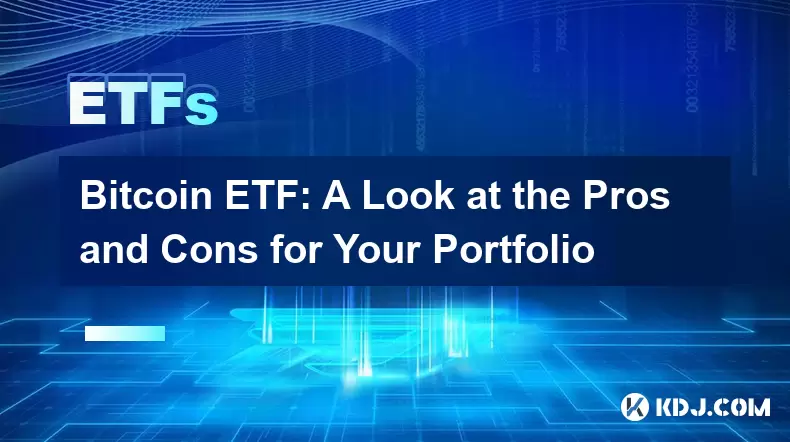
Bitcoin ETF: A Look at the Pros and Cons for Your Portfolio
Aug 08,2025 at 10:43am
Understanding Bitcoin ETFs and Their Role in InvestmentA Bitcoin Exchange-Traded Fund (ETF) is a financial product that allows investors to gain expos...
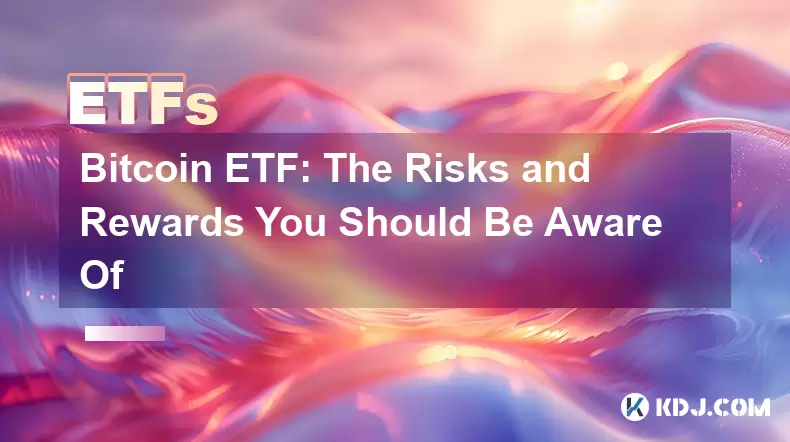
Bitcoin ETF: The Risks and Rewards You Should Be Aware Of
Aug 07,2025 at 03:07pm
What Is a Bitcoin ETF and How Does It Work?A Bitcoin ETF (Exchange-Traded Fund) is a financial product that tracks the price of Bitcoin and trades on ...
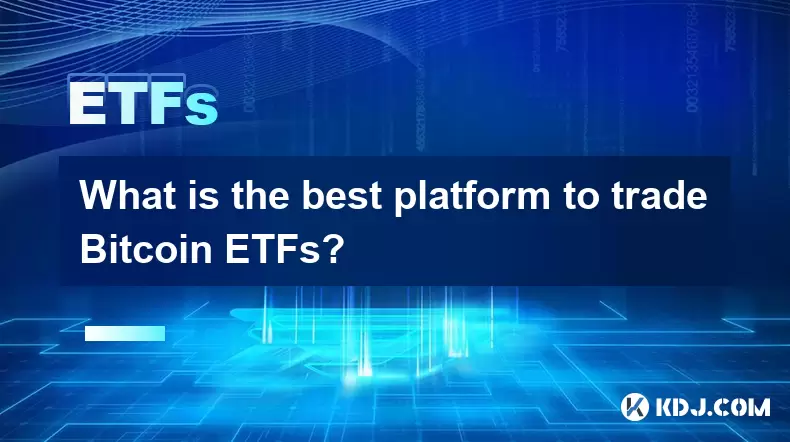
What is the best platform to trade Bitcoin ETFs?
Jul 23,2025 at 04:14am
Understanding Bitcoin ETFs and Their Role in TradingBitcoin Exchange-Traded Funds (ETFs) have gained significant traction among traditional and crypto...
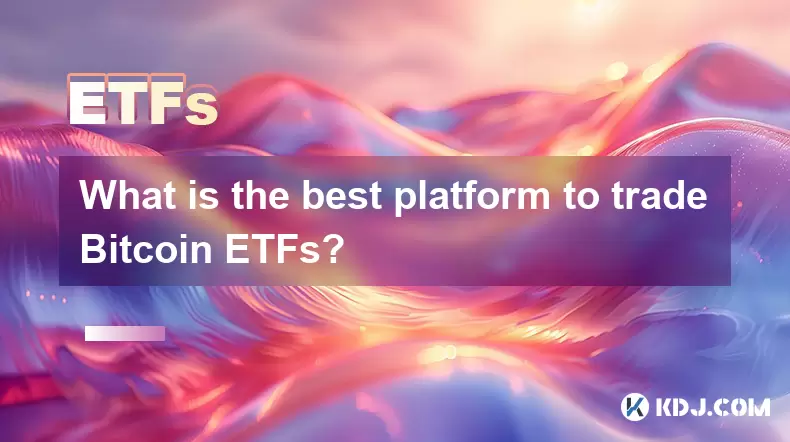
What is the best platform to trade Bitcoin ETFs?
Jul 17,2025 at 03:50pm
Understanding Bitcoin ETFs and Their Role in the MarketBitcoin Exchange-Traded Funds (ETFs) are investment vehicles that track the price of Bitcoin wi...
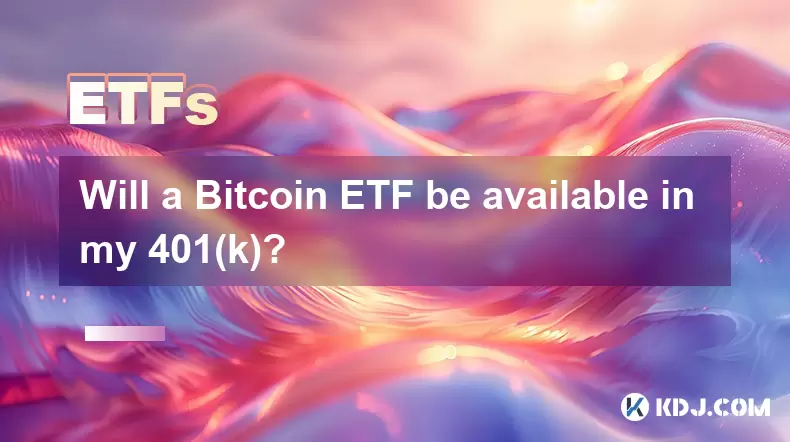
Will a Bitcoin ETF be available in my 401(k)?
Jul 17,2025 at 10:42pm
What is a Bitcoin ETF?A Bitcoin ETF (Exchange-Traded Fund) is an investment vehicle that tracks the price of Bitcoin without requiring investors to di...

Bitcoin ETF: How to Choose the Right One for Your Investment Strategy
Aug 09,2025 at 11:49am
Understanding Bitcoin ETFs and Their Market RoleA Bitcoin ETF (Exchange-Traded Fund) is a financial product that tracks the price of Bitcoin without r...

Bitcoin ETF: A Look at the Pros and Cons for Your Portfolio
Aug 08,2025 at 10:43am
Understanding Bitcoin ETFs and Their Role in InvestmentA Bitcoin Exchange-Traded Fund (ETF) is a financial product that allows investors to gain expos...

Bitcoin ETF: The Risks and Rewards You Should Be Aware Of
Aug 07,2025 at 03:07pm
What Is a Bitcoin ETF and How Does It Work?A Bitcoin ETF (Exchange-Traded Fund) is a financial product that tracks the price of Bitcoin and trades on ...

What is the best platform to trade Bitcoin ETFs?
Jul 23,2025 at 04:14am
Understanding Bitcoin ETFs and Their Role in TradingBitcoin Exchange-Traded Funds (ETFs) have gained significant traction among traditional and crypto...

What is the best platform to trade Bitcoin ETFs?
Jul 17,2025 at 03:50pm
Understanding Bitcoin ETFs and Their Role in the MarketBitcoin Exchange-Traded Funds (ETFs) are investment vehicles that track the price of Bitcoin wi...

Will a Bitcoin ETF be available in my 401(k)?
Jul 17,2025 at 10:42pm
What is a Bitcoin ETF?A Bitcoin ETF (Exchange-Traded Fund) is an investment vehicle that tracks the price of Bitcoin without requiring investors to di...
See all articles

























































































